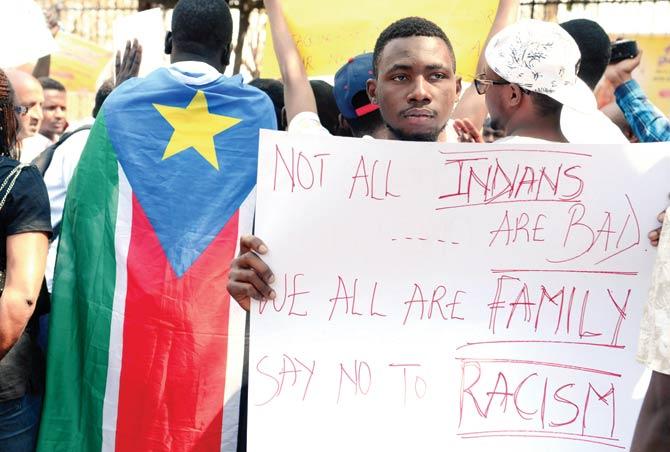Years ago, a child’s innocent question opened this columnist’s eyes to the debate on caste, colour and race that rages on even to this day

 When I was a boy, maybe five-six years old, I stumbled in the school playground, fell and scraped my fingers. There was blood. A best friend was astonished: “You don’t bleed black?” he asked.
When I was a boy, maybe five-six years old, I stumbled in the school playground, fell and scraped my fingers. There was blood. A best friend was astonished: “You don’t bleed black?” he asked.
ADVERTISEMENT
I’ve always dismissed this as an innocent child’s question, for in 1960s England, I was the odd boy out in our Grimsby school in the Midlands, where my father treated pulmonary diseases in coal-mining families. But it got stranger when, as a seven-year-old, I returned to north Bihar. We lived with my maternal grandparents near the railway line approaching Muzaffarpur junction, and I was warned not to mix with the boys who played along the tracks. Still, I received a severe scolding and was made to bathe after a cousin once alleged: “He touched a Dom.” The Dom is a Dalit, a scavenger, who removes carcasses. For the privileged, the Dom was also a joke: the exclusive Don Bosco School in Patna was called “Dom ka Boss” school.

African students at a rally in Hyderabad on Saturday, in support of the Tanzanian nationals who were assaulted by a mob in Bangalore. It is absurd to hear the government repeatedly deny that racism played a part in the attack. Pic/AFP
Life in Bihar also cured me of clour-blindness. Aunts casually tossed around judgments that so-and-so “ka rang saaf hai” or was a “kariya”. A nonsense rhyme went “kaali kalutthi, baigan lutthi” about a girl black as an eggplant. My father once needled my mother that if not for him she would have married a “kaala” engineer.
When I was ten, we migrated to Flushing, New York, where we lived in a low-cost, high-rise apartment. The Carlyle Towers had a high African-American population, and we understood we had to avoid them, not just because of their skin colour but also their violence. Black kids were forever beating up immigrants, me included. When I entered Std VII, our social studies teacher mentioned a politician who wanted to ship all Blacks “back to Africa”. The politician is a racist, he said. Hmm, I thought. So are my parents.
I then noticed Black girls in my classroom, and despite their funny hair, they were notable to a boy hitting puberty. White kids did not mix with them; they too kept to themselves. This segregation was especially noticeable at Stuyvesant High School, an exclusive science and math school that has apparently produced the highest number of Nobel laureates. All may have passed the test, but were not equally accepted. I now believe that meritocracy is a sham; a subtle, complex and twisted sham.
My parents’ most terrifying fear was that as an adult I might marry a Black girl. Such a scandal had already hit the Bihari immigrant community, imposing on the concerned parents another exile in exile. Ironically, almost none of the patients at my father’s north Bronx clinic were white. Bihari-Americans wanted their children, particularly their daughters, to marry Biharis, preferably imported from the source. I don’t think a single arranged marriage survived.
Bihari-Americans weren’t just racist. The Bihar Association of North America (BANA) organised fun gatherings, particularly on Holi and Diwali. Even my father was a one-term BANA president. But once there was a disputed election and a sub-group threatened to walk out: “It’s not BANA, it’s KANA,” they alleged, implying it had become a Kayastha Association. Laughable, but true.
When President Barack Obama was elected, America seemed to have lived up to its self-image of ‘Exceptionalism’, as the biblical ‘City on the Hill’. Yet, the fierce hostility that Obama faced during his eight years proves that around half his country still has a deep racial prejudice. India once elected a woman prime minister but that was an accident of circumstance, not the outcome of Hindu tolerance. If a Dalit was president of India, it was only tokenism.
It is thus absurd to hear the government repeatedly deny that racism played a part in the mob attack in Bangalore this week in which a Tanzanian student was assaulted. “Indians are not racist,” an RSS ideologue categorically stated on TV, much in the same way BJP ministers have parroted that “Rohith Vemula was not a Dalit”, simply because he was adopted by an OBC family.
If Indians aren’t racist, how do you explain the popularity of Priyanka Gandhi?
Bangaloreans — upset that a local mob (to be fair, mob violence after road accidents are not uncommon) has sullied their city’s name — have resorted to whataboutery, citing irrelevant ‘facts’ like the ‘criminal’ behaviour of ‘African’ students, or the group identity of the mob. It sucks when your city or community is unfairly under attack — but that goes for both Bangaloreans as well as Blacks. The truth lies closer not to the jalebi-explanations of the privileged, but the raw feelings of the marginalised.
We have two doggies at home, a pure-bred Golden Retriever and a mongrel rescued from the streets of central Mumbai. One is white as snow; the other muddy-brown with a large black patch. Guess which one our neighbours, relatives and friends gush over.
Journalist and writer Aditya Sinha is the co-author of Kashmir: The Vajpayee Years. He tweets @autumnshade. Send your feedback to mailbag@mid-day.com
 Subscribe today by clicking the link and stay updated with the latest news!" Click here!
Subscribe today by clicking the link and stay updated with the latest news!" Click here!






